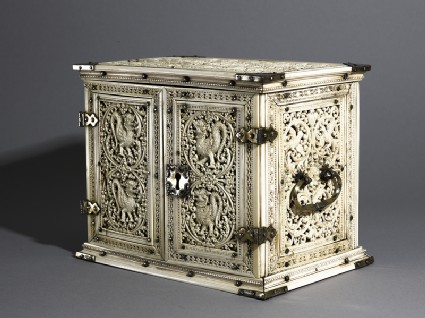Search Results: objects
Show search help- Reference URL
Actions
Ivory cabinet
-
Description
The Dutch East India Company maintained a number of trading posts in India and Ceylon (now Sri Lanka) as part of their Asian network in the seventeenth century. Local wood and ivory craftsmen were able to produce fine furniture, European in form but richly hybrid in decoration, either for local Company officials or for export.
The top panel of this cabinet shows a Dutch party being received among the huts and palms of a seaport in Ceylon, while their ships ride at anchor. The back shows the climax of an elephant hunt, with six wild elephants penned in a stockade and European soldiers in the foreground. The door panels have pairs of a lion-headed variant of the auspicious hamsa bird, a common motif in the later ivory and metalwork of Ceylon. Traditional foliated scrollwork, with parrots and lion-headed serapendiyas (mythical creatures), appear on the front and side panels.
-
Details
- Associated place
- Date
- 2nd half of the 17th century
- Material and technique
- wood and tortoiseshell, overlaid with carved ivory decoration, and with silver gilt and brass gilt, and traces of red pigment
- Dimensions
- 19 x 24 x 15.5 cm (height x width x depth)
- Material index
-
organic › animal › carapace › tortoise carapace › tortoise-shell,processed material › metal › gold,processed material › metal › alloy › copper alloy › brass,organic › animal › tooth › mammal tooth › ivory
- Technique index
-
covered › metallized › gilded
- Object type index
- No. of items
- 1
- Credit line
- Purchased with the assistance of the Friends of the Ashmolean Museum, 1976.
- Accession no.
- EA1976.6
-
Further reading
Harle, J. C., and Andrew Topsfield, Indian Art in the Ashmolean Museum (Oxford: Ashmolean Museum, 1987), no. 103 on pp. 91-92, illus. pp. 91-92
Seneviratna, Anuradha, Anusmrti: Thoughts on Sinhala Culture and Civilization, 2 vols (Wellampitiya: Godage International Publishers, 2003), illus. pp. 194-198
Oxford: Ashmolean Museum, 24 May 2006-23 December 2008, Treasures: Antiquities, Eastern Art, Coins, and Casts: Exhibition Guide, Rune Frederiksen, ed. (Oxford: Ashmolean Museum, 2006), no. 150 on p. 54, illus. p. 54
Veenendaal, Jan, Asian Art and Dutch Taste, Titus M. Eliens, ed. (Zwolle and the Hague: Gemeentemuseum, 2014), p. 39, fig. 47
Location
-
- currently out on loan
Objects are sometimes moved to a different location. Our object location data is usually updated on a monthly basis. Contact the Jameel Study Centre if you are planning to visit the museum to see a particular object on display, or would like to arrange an appointment to see an object in our reserve collections.
Galleries
Publications online
-

Indian Art in the Ashmolean Museum
In the 17th century the vigorous and highly organised Dutch East India Company built up an unrivalled Asian trading network which included a near-monopoly of the lucrative spices of Indonesia. As part of this commercial empire the Dutch established a number of trading posts in India and in the coastal regions of Ceylon, from which was the last Portuguese stronghold had been removed by 1658. In Ceylon they were able to advantage of the ancient indigenous traditions of wood and ivory-carving. Considerable quantities were produced after Dutch models, similar to the work associated with the Company’s headquarters of Batavia (modern Jakarta), as seen for example in two carved ebony chairs said to have been owned by Charles II’s queen Catherine of Braganza, which came to the Museum from Elias Ashmole in 1683.
The ivory carvers of Ceylon were already accustomed to producing fine pieces in the European (Portuguese) taste as export or presentation items, as is shown by a small surviving group of elaborate caskets incorporating Christian and European imagery which date from the mid-16th century. The Museum’s cabinet is a similarly hybrid production, although of a later type. It is overlaid with carved ivory panels, mingling scenes of Europeans with traditional decoration. The top panel shows the reception of a European party among the huts and palms of a port in Ceylon, with several ships riding at anchor among billowing waves. The back panel depicts the culmination of an elephant hunt, with six elephants penned in a stockade and four European soldiers among the participants. The two sides of the cabinet are decorated with intricate foliated scrollwork, with a pair of flying parrots, around a central lotus rosette. The door panels have pairs of fiercely strutting śerapendiyas (or śarapendās), a lion-headed variant of the auspicious haṁsa bird which is a common motif in the later ivory and metalwork of Ceylon. The five internal drawers are decorated in a similar style.
© 2013 University of Oxford - Ashmolean Museum











